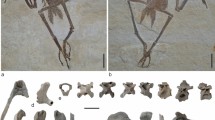Abstract
First primate remains from the eocene “oil-shale” of Messel are described. It is the skeleton of the lower part of the body. Since teeth are missing it can only be determined as Adapidae gen. et sp. indet. It differs fromAdapis in the proportions of the calcaneus. The foot shows an opposable and broadened hallux. The second toe is differentiated as a “toilet-digit” like in modern lemurs. The skeleton includes a baculum of unexpected size for a primate.
Kurzfassung
Aus dem eozänen Ölschiefer von Messel wird der erste Fund eines Primaten beschrieben. Es handelt sich um ein Teilskelett der hinteren Körperhälfte. Da Gebißreste fehlen, kann eine Bestimmung nur als Adapidae gen. et sp. indet. erfolgen. VonAdapis unterscheidet sich der Fund u. a. in den Proportionen des Calcaneus. Der Fuß zeigt die voile Spezialisierung zu einem Greiforgan mit abspreizbarem, verbreitertem 1. Strahl. Der 2. Strahl ist wie bei den rezenten Lemuren zur Putzzehe umgebildet. Zum Teilskelett gehört ein für Primaten ungewöhnlich großes Baculum.
Similar content being viewed by others
Literatur
Blainville, D. de (1839): Ostéographie ou description iconographique ... des mammifères. — Paris 1839–1864 (Lemur: Teil D, 1839).
Feneis, H. (1974): Anatomisches Bildwörterbuch. — Stuttgart (Georg Thieme).
Fiedler, W. (1959): Öber das Baculum der Cheirogaleinae (Primates). — Zool. Anz.,163: 57–63; Leipzig.
Filhol, H. (1883): Observations relatives au mémoire de M. Cope intitulé: Relation des Horizons renfermant des débris d’animaux vertébrés fossiles en Europe et en Amerique. — Ann. Sci. Geol.,14/5: 1–51; Paris.
Franzen, J. (1977): Urpferdchen und Krokodile. — Kl. Senckenberg-Reihe,7; Frankfurt.
Gregory, W. K. (1920): On the structure and relations ofNotharctus, an American Eocene Primate. — Mem. Amer. Mus. natur. Hist., n. S.3: 49–243; New York.
Hill, W. C. O. (1953): Primates, 1. Strepsirhini. — Edinburgh (University Press).
Kaudern, W. (1911): Studien über die männlichen Geschlechtsorgane von Insectivoren und Lemuriden. — Zool. Jb., Abt. Anat. Ontog.,31: 1–106; Jena.
Koenigswald, W. v. (1979): Die Erforschung der Fossilien der Messeler Schichten. — In:Heil, R.;Koenigswald, W. v. &Lippmann, H. G.: Fossilien der Messeler Schichten. — Darmstadt (Hessisches Landesmuseum). (Mit Artenliste der seit Tobien [1969 b] erfolgten Bearbeitungen; vgl. S. 65.)
Lippmann, H. G. &Wiemer, G. (1979): Bergung und Präparation von Fossilien aus der Grube Messel unter Berücksichtigung eines Primatenfundes. — Der Präparator25: 3–13; Bochum.
Matthess, G. (1966): Zur Geologie des Ölschiefervorkommens von Messel bei Darmstadt. — Abh. hess. L.-Amt Bodenforsch.,51, 87 S.; Wiesbaden.
McKenna, M. C. (1967): Classification, range and deployment of the prosimian primates. — Probl. act. Paleont. Evol. Vertébr. CNRS; 603–610; Paris.
Milne-Edwards, A. &Grandidier, A. (1875): Histoire naturelle des Mammifères,4, Atlas1 — In:Grandidier, A. (1875): Histoire physique, naturelle et politique de Madagascar; Paris.
Pohl, L. (1910): Beiträge zur Kenntnis des os penis der Prosimier. — Anat. Anz.,37: 225–231; Jena.
Russel, D. E. (1964): Les Mammifères Paléocènes d’Europe. — Mém. Mus. nat. Hist. natur. N. S. C,13; Paris.
Russel, D. E.;Louis, P. &Savage, D. E. (1967): Primates of the french early Eocene. — Univ. Calif. Publ. — Bull. Dept. geol. Sci.,73: 1–44; Berkeley.
Schlosser, M. (1907): Beitrag zur Osteologie und systematischen Stellung der GattungNecrolemur sowie zur Stammesgeschichte der Primaten überhaupt. — N. Jb. Miner, etc.,1907: 197–226; Stuttgart.
Simons, E. L. (1962): A new eocene primate genus,Cantius, and a revision of some allied european Lemuroids. — Bull. Brit. Mus. (natur. Hist.) — Geol.7 ((1), 36 S.; London.
Starck, D. (1974): Die Stellung der Hominidae im Rahmen der Säugetiere. — In:Heberer, G. [Hrsg.]: Die Evolution der Organismen III. Phylogenie der Hominiden: 1–131; — Stuttgart (G. Fisdier).
Stehlin, H. G. (1912 u. 1916): Die Säugetiere des Schweizer Eozäns. Critischer Catalog der Materialien, 7. Teil. — Abh. Schweizer Paläont. Ges.,38: 1165–1298, und41: 1297-1552; Basel.
Szalay, F. S. (1976): Systematics of the Omomyidae (Tarsiformes, Primates) Taxonomy Phytogeny, and Adaptations. — Bull. Amer. Mus. natur. Hist.,156 (3); 159–449; New York.
Thenius, E. (1969): Phylogenie der Mammalia, Stammesgeschichte der Säugetiere (einschließlich der Hominidae). — Berlin (de Gruyter).
Tobien, H. (1968): Mammifères éocènes du basin du Mayence et de la partie orientale du fossé rhénan. — Mém. Bur. Rech. géol. et min.,58: 297–307; Paris.
—— (1968): Das biostratigraphische Alter der mitteleozänen Fossilfundstelle Messel bei Darmstadt (Hessen). — Notizbl. hess. L.-Amt Bodenforsch.,96: 111–119; Wiesbaden.
—— (1969 a):Kopidodon (Condylarthra, Mammalia) aus dem Mitteleozän (Lutetium) von Messel bei Darmstadt (Hessen). — Notizbl. hess. L.-Amt Bodenforsch.,97: 7–37; Wiesbaden.
—— (1969 b): Die alttertiäre (mitteleozäne) Fossilfundstätte Messel bei Darmstadt (Hessen). — Mz. naturw. Archiv,8: 149–180; Mainz.
van Valen, L. (1967): New Paleocene Insectivores and Insectivore Classification. — Bull. Amer. Mus. natur. Hist.,135: 217–284; New York.
Weigelt, J. (1927): Rezente Wirbeltierleichen und ihre paläo-biologische Bedeutung. — Leipzig (Max Weg).
—— (1933): Neue Primaten aus der mitteleozänen (oberlutetischen) Braunkohle des Geiseltals. — Nova Acta Leopold., N. F.,1: 97–156; Halle.
Weitzel, K. (1932):Cryptopithecus macrognathus, Wittich, von Messel ist kein Primate, sondern ein Creodontier. — Centralbl. Min. etc.,1932, Abt. B.,12: 617–618; Stuttgart.
Wittich, E. (1902):Cryptopithecus macrognathus n. spec, ein neuer Primate aus den Braunkohlen von Messel. — Centralbl. Min. etc.1902: 289–294; Stuttgart.
Author information
Authors and Affiliations
Rights and permissions
About this article
Cite this article
Koenigswald, W.V. Ein Lemurenrest aus dem eozänen Ölschiefer der Grube Messel bei Darmstadt. Paläontol. Z. 53, 63–76 (1979). https://doi.org/10.1007/BF02987788
Received:
Issue Date:
DOI: https://doi.org/10.1007/BF02987788




